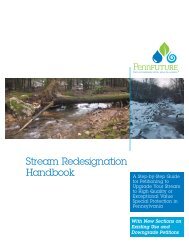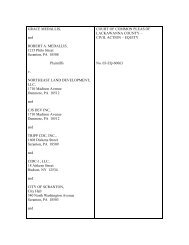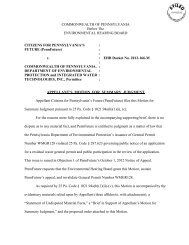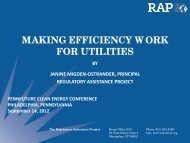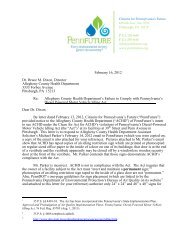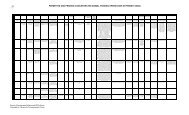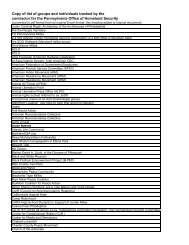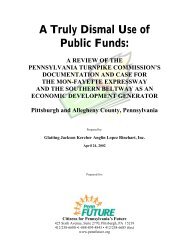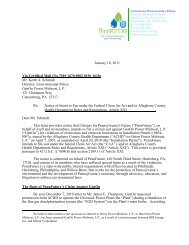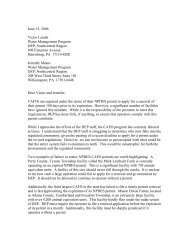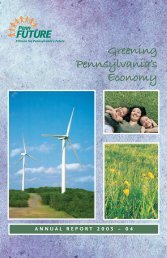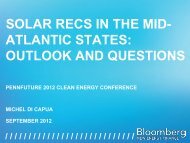A Review of the Pennsylvania Phosphorus Index ... - PennFuture
A Review of the Pennsylvania Phosphorus Index ... - PennFuture
A Review of the Pennsylvania Phosphorus Index ... - PennFuture
Create successful ePaper yourself
Turn your PDF publications into a flip-book with our unique Google optimized e-Paper software.
overestimation is incorporated into <strong>the</strong> establishment <strong>of</strong> <strong>the</strong> P-<strong>Index</strong> ranking thresholds atcertain quantities <strong>of</strong> allowable P loss. When WEP-based PSCs are used, <strong>the</strong> P-Indices that resultare lower than those calculated using Book value P-Indices, all else being equal, however, <strong>the</strong>actual P loss would not have changed. Hence, <strong>the</strong> amount <strong>of</strong> P loss across <strong>the</strong> P-<strong>Index</strong> rankingswould be higher than that modeled by Sharpley et al (2001).While it seems appropriate that construction <strong>of</strong> <strong>the</strong> P-<strong>Index</strong> model be undertaken byagricultural technical experts, <strong>the</strong> setting <strong>of</strong> <strong>the</strong> allowable P loss from <strong>the</strong> farm field edge is apolicy decision, beyond <strong>the</strong> technical modeling <strong>of</strong> P delivery. Beegle (pers. comm.) suggestedthat <strong>the</strong> P-<strong>Index</strong> model thresholds were set with reference to <strong>the</strong> amount <strong>of</strong> P allowed to bedischarged by waste water treatment plants with strict effluent limits. Fur<strong>the</strong>r, Beegle <strong>of</strong>feredthat <strong>the</strong> P-<strong>Index</strong> was designed to identify risk levels <strong>of</strong> P run<strong>of</strong>f not specific loss rates <strong>of</strong> P.However, it is appropriate to ask whe<strong>the</strong>r setting farm field run<strong>of</strong>f at a P concentrationequivalent to waste water treatment plant effluent is appropriate? (Given <strong>the</strong> use <strong>of</strong> WEPmeasurementbased PSC’s, <strong>the</strong> P losses could be even higher.) The answer to this question maybe best addressed by trying to better understand <strong>the</strong> impact <strong>of</strong> setting <strong>the</strong> P-<strong>Index</strong> rankingthresholds at certain levels <strong>of</strong> P run<strong>of</strong>f. What would be <strong>the</strong> loading impact if all <strong>the</strong> farms thathave P-Indices which require consideration <strong>of</strong> phosphorus loss, have P run<strong>of</strong>f at 200 or 350 gP/ha? The Sharpley et al (2001) model also assumes some specific volume <strong>of</strong> run<strong>of</strong>f from farms;what is that volume and how does that value influence <strong>the</strong> estimate <strong>of</strong> loss <strong>of</strong> P from farms? Toallow a better assessment <strong>of</strong> <strong>the</strong> impacts <strong>of</strong> P loading from manure application, <strong>the</strong> loss <strong>of</strong> Pfrom farm fields using WEP-measurement based PSC’s in aggregate across a watershed shouldbe modeled.<strong>Pennsylvania</strong> changed <strong>the</strong> variables by which it allows nutrient managers to determineappropriate P management but <strong>the</strong>re has been no coordinated effort to monitor how this changehas affected actual P management. The Commonwealth needs to collect data on P management,P-Indices and PSC’s so it can evaluate how <strong>the</strong> current P-<strong>Index</strong> management approach isworking. Models relating P-<strong>Index</strong> rankings to P run<strong>of</strong>f need to be recalculated using <strong>the</strong> newparameters. Fur<strong>the</strong>rmore, targeted watershed monitoring <strong>of</strong> actual farm field P loss andtransport in rivers based upon <strong>the</strong> current management strategies should be undertaken.Over <strong>the</strong> long term, <strong>the</strong> current approach to agricultural P management is unsustainable. MoreP is being imported into counties with high livestock and poultry densities within feed grainsthan is being exported as agricultural products (Gburek et al 2000.) This imbalance means Pwill continue to accumulate in soils and <strong>the</strong> problem <strong>of</strong> loss from farm fields will continue to getworse. Attention needs to be given to a long term solution that restores <strong>the</strong> import/export Pbalance within a watershed.ConclusionsChanges in <strong>the</strong> P-<strong>Index</strong> between Version 1 and Version 2 are likely to result in: a) more farmfields assessed for risk <strong>of</strong> P loss given <strong>the</strong> addition <strong>of</strong> 2 conditions to <strong>the</strong> Part A Screening test,but; b) fewer fields having P application restrictions or having lesser P restrictions as <strong>the</strong> WEPmeasurementbased PSC’s are likely to lower P-<strong>Index</strong> rankings. The scientific support forPage 12



